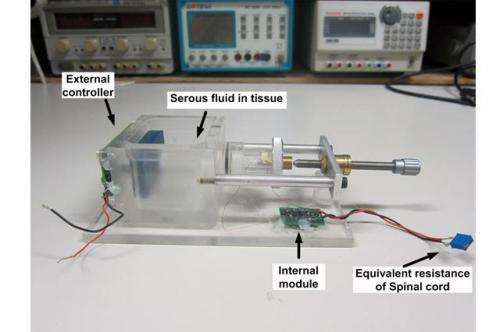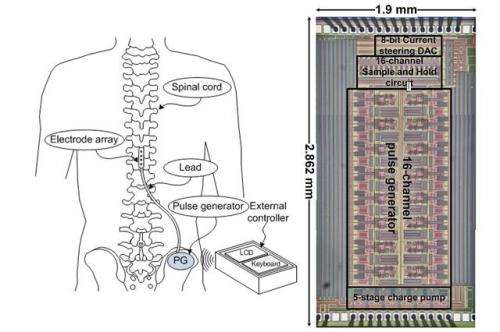New technology reduces size of spinal stimulator implants

Spinal cord stimulator implants could use less power and be made much smaller as work from Taiwan and Israel eliminates off-chip high-voltage devices from the implant's pulse generator. This will reduce implant-related discomfort for patients using such implants to control chronic pain, and the work could also be applied to other medical devices, including muscle micro-stimulators.
Packaging problems
For a growing number of people, spinal cord stimulators (SCSs) provide a low-cost alternative to pharmaceutical pain relief with fewer side effects. An SCS delivers electrical impulses to the patient's spinal cord, which help to control the pain they experience. A typical SCS consists of an external controller unit and an internal module, wirelessly connected to each other.
The internal module, implanted in the patient, will include three main components. The first is the electrode array, attached to the outermost part of the spinal canal, to deliver the electrical pulses to the spinal cord. The second is the pulse generator that produces the required pulses and is implanted away from the spine in a location with more space, such as the lower abdomen. The final component is the lead that connects the generator to the electrode array.
A key issue with current SCS designs is the need for off-chip power devices, because the stimulating pulses that have to be generated are relatively high voltage. The off-chip devices add bulk to the pulse generator, which has to be implanted in the body. This limits the choice of implantation location for the pulse generator module and increases the discomfort for the patient associated with the implant.
All on-chip

In this issue of Electronics Letters, a team from National Sun Yat-Sen University, Taiwan, and Tel Aviv University, Israel, presents a compact pulse generator with no off-chip power devices, created using a high voltage (HV) CMOS process.
Their 16-channel high-voltage stimulation generator uses a charge pump composed of five cascaded voltage doublers to boost the core voltage (2.5 V) to over 10 V, meeting the requirements of an SCS. The generator is capable of producing different pulse waveforms to meet a range of different application requirements. "A total of 16 stimulation waveform generators are included to drive 16 corresponding sets of electrodes, where each generator is composed of a high-voltage operational amplifier and high-voltage analogue switch. They are meant to be programmable and digitally controllable," explained team member Prof. Chua-Chin Wang.
Although HV CMOS is a known technology, moving the design to it from a standard CMOS process was not straightforward, imposing many design restrictions. For example, although the HV CMOS can sustain a voltage drop between drain and source of over 60 V, the voltage drop between gate and source is limited to 5 V, which required the development of a corresponding protection mechanism.
However, now that the pulse generator has been realised, it should be relatively simple to use it as a direct replacement for much bulkier units with off-chip power components, giving the design great potential for rapid uptake in clinical devices.
Powerful sounds
The HV CMOS design produced by the team already requires less power to operate than previous designs, but the team is now working to further reduce the power consumption. This is always a very important consideration for implanted devices, which have to be either wirelessly powered externally (or charged), or require repeated surgical procedures to replace batteries.
The team are also working more widely on the development of complete SCS systems with wireless power transmission and wireless communication between the controller and the implanted components. This includes the use of ultrasonic transmitters and receivers as well as more conventional EM methods, since ultrasound has a long history in medical use to prove its safety.
The team have already produced an ultrasound-based prototype SCS that uses the pulse generator presented in this issue of Electronics Letters. Early results suggest that the efficiency of the power transfer will be an issue that needs to be addressed and Wang commented that this also drives the need to further reduce the power consumption of the implanted components, including the pulse generator, "In the future, the life time extension of the battery in the SCS internal module will become a major problem. Since the conversion efficiency of the wireless charger remains a task to beat, power saving in the internal module will be increasingly important to reduce the number of charging times and the heat dissipation."
More information: "±10.5 V 16-channel programmable pulse generator using high-voltage BCD CMOS process." Electronics Letters, Volume 50, Issue 24, 20 November 2014, p. 1797 – 1799 DOI: 10.1049/el.2014.1766 , Print ISSN 0013-5194, Online ISSN 1350-911X
Journal information: Electronics Letters
Provided by Institution of Engineering and Technology





















